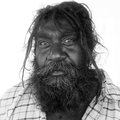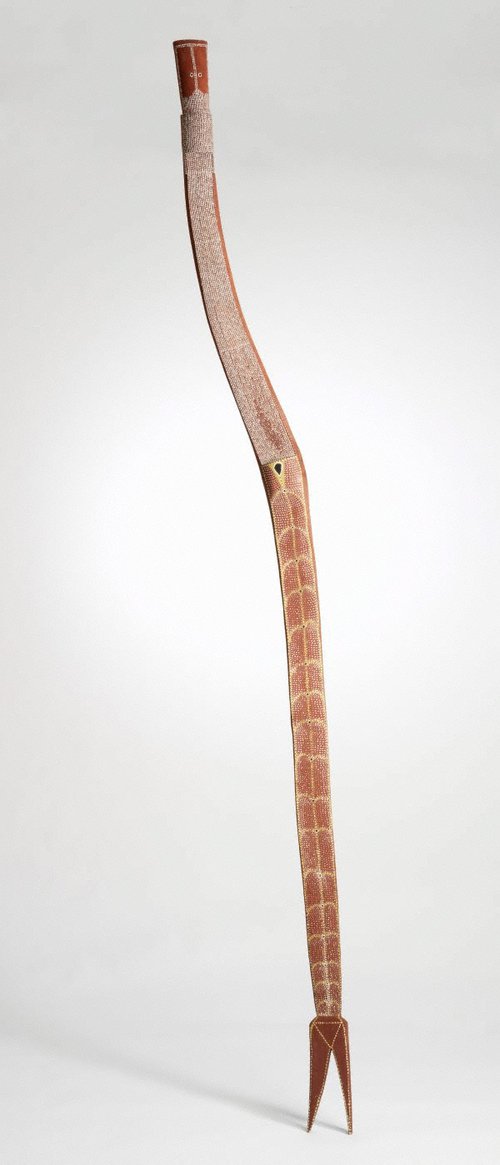Title
Yawkyawk
1999
Artist
-
Details
- Other Title
- Yawk Yawk
- Place where the work was made
-
Maningrida
→
Central Arnhem Land
→
Northern Territory
→
Australia
- Date
- 1999
- Media category
- Sculpture
- Materials used
- natural pigments on Kurrajong wood
- Dimensions
- 261.5 x 12.2 x 8.5 cm
- Signature & date
Not signed. Not dated.
- Credit
- Mollie Gowing Acquisition fund for Contemporary Aboriginal art 2000
- Location
- Not on display
- Accession number
- 78.2000
- Copyright
- © Owen Yalandja/Copyright Agency
- Artist information
-
 Owen Yalandja
Owen Yalandja
Works in the collection
- Share
-
-
About
Owen Yalandja, like his brother Crusoe Kurddal, maintains his father Crusoe Kuningbal's patrimony of artistic inspiration in wood carving. Yalandja lives at Barrihdjowkkeng outstation, a camp established by his father and adjacent to a billabong that is a Yirridjdja moiety sacred site for the yawkyawk or young girl spirits. Yawkyawk live in this billabong and their shadows can occasionally be seen as they flee the smell of humans who approach the water. They are imagined to have been girls who transformed into mermaid-like figures with fish tails. While many bark painters in the region have depicted yawkyawk, Yalandja has developed the mimih form created by his father to create his own new form of carving, as in 'Yawkyawk', 1999. One innovative work from 1993 makes use of a natural fork in a tree to create the tail of a mermaid figure. More recently, Yalandja's sculptures have torsos that are much like that of the standard mimih, but with a tapering lower body and forked fish tail. Yalandja also asserts his unique approach by using a black background, as well as the more common red background to these figures. In the early 1990s, he experimented with the dot patterns his father taught him, and created new arrangements – first in arcs to suggest scales, and later, small 'v' shaped marks to suggest individual scales. He uses this graphic innovation to capture the scaly sheen of the watery being.
Yalandja now specialises in producing larger fine art pieces. He favours the wood of the kurrajong tree for carving because it has good strength across the grain, allowing him to incorporate three-dimensional carved elements without the concern that the trunk will split. Yalandja's recent innovations include the selection of more curvilinear tree trunks to give his figures a sinuous appearance. Very thin and waving trunks provide an even more attenuated form. These innovations in three-dimensional form are appropriate to the meaning of the figure, capturing as they do the sinuous movements of the yawkyawk's swimming form.
Luke Taylor in 'Tradition today: Indigenous art in Australia', Art Gallery of New South Wales, Sydney, 2004
© Art Gallery of New South Wales
-
Places
Where the work was made
Maningrida
-
Exhibition history
Shown in 4 exhibitions
Biennale of Sydney 2000, Museum of Contemporary Art, Australia, 26 May 2000–30 Jul 2000
Crossing country: the alchemy of Western Arnhem Land art, Art Gallery of New South Wales, Sydney, 24 Sep 2004–12 Dec 2004
One sun, one moon, Art Gallery of New South Wales, Sydney, 03 Jul 2007–02 Dec 2007
Sentient lands, Art Gallery of New South Wales, Sydney, 04 Jun 2016–08 Oct 2017
Sentient lands, Art Gallery of New South Wales, Sydney, 21 Jan 2017–08 Oct 2017
-
Bibliography
Referenced in 6 publications
-
Ewen McDonald (Editor), Biennale of Sydney 2000, Sydney, 2000, 78, 79 (colour illus.). no catalogue numbers
-
Hetti Perkins, Art + soul: a journey into the world of Aboriginal art, 'Home + away', pg. 1-86, Carlton, 2010, 45 (colour illus.), 279.
-
Hetti Perkins, Crossing country: the alchemy of western Arnhem Land art, Sydney, 2004, 202 (colour illus.), 231.
-
Public Programmes Department, Art Gallery of New South Wales, Crossing country: the alchemy of western Arnhem Land art, 'Maningrida Arts and Culture', Sydney, 2004, (colour illus.).
-
Luke Taylor, One sun one moon: Aboriginal art in Australia, ‘Painting Djang: Art and inspiration in Western Arnhem Land’, pg. 85-91, Sydney, 2007, 90 (colour illus.).
-
Luke Taylor, Tradition today: Indigenous art in Australia, 'Owen Yalandja', pg. 176, Sydney, 2004, 176, 177 (colour illus.).
-


